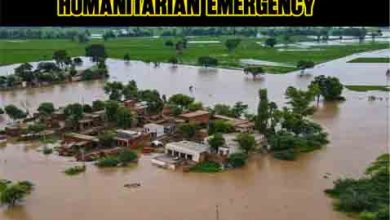First Monsoon Spell in Pakistan to Start June 25: Met Office Issues Flood Warning
The Pakistan Meteorological Department warns that the first monsoon spell in Pakistan will hit from June 25, with chances of heavy rainfall and flooding in vulnerable regions.
The first monsoon spell in Pakistan is expected to begin on June 25 and continue until July 2, according to the latest advisory by the Pakistan Meteorological Department (PMD). This annual weather phenomenon brings much-needed rain but also raises critical concerns about urban flooding, landslides, and glacier melting.
As temperatures soar and heatwaves grip the plains, the impending monsoon season is set to bring a dramatic shift in the country’s weather pattern. Authorities are on high alert to mitigate the potentially devastating effects of this season’s above-normal rainfall.
Met Office Forecast for Karachi and Beyond
According to Anjum Nazir Zegham, Deputy Director of the Met Office, Karachi will begin experiencing cloudy weather from June 19, with drizzles expected during the early morning and late evening hours. The hot weather in Karachi is being driven by a low-pressure system over the Arabian Sea.
This weather development will mark the onset of the monsoon, which will gradually extend toward other parts of Sindh, Punjab, and northern areas.
Nationwide Monsoon Outlook from June 25 to July 2
The PMD predicts that during this period:
- Eastern Punjab, southeastern Sindh, Gilgit-Baltistan, and Azad Kashmir will likely see moderate to heavy rainfall.
- Strong winds and thunderstorms may accompany the rainfall in these regions.
- The rest of the country will remain hot to extremely hot, particularly in southern and central Pakistan.
This confirms earlier forecasts by the National Disaster Management Authority (NDMA) that the monsoon season will arrive earlier than usual this year.
NDMA’s Urgent Warning: Risk of Heavy Rainfall and Floods
Earlier this year, the NDMA informed the Senate Standing Committee on Climate Change that heavier-than-average rainfall is expected nationwide, especially starting from June 26–27.
Key highlights from the NDMA briefing:
- Rainfall levels could exceed normal averages by up to 5% across Pakistan.
- Northeastern Punjab may experience a 50% increase in rainfall.
- There is a heightened risk of urban flooding, landslides, and glacier lake outburst floods (GLOFs).
These critical warnings necessitate early preparedness, particularly in low-lying and mountainous areas.
Regional Breakdown: Rainfall Predictions Across Provinces
Punjab
- Usual rainfall: 344mm
- Forecasted rainfall: 388mm
- Affected cities: Lahore, Sialkot, Narowal, Gujranwala
- Risks: Urban flooding and waterlogging
Khyber Pakhtunkhwa (KP)
- Normal: 243mm
- Expected: Up to 300mm
- Southern KP: Above-normal rainfall
- Northern KP: Below-normal rainfall
Sindh
- Southeastern parts (including Tharparkar, Badin, Hyderabad): Moderate rainfall expected.
- Karachi: Light to moderate drizzle with humid conditions
Balochistan
- Expected to receive below-normal rainfall, though temperatures will remain above seasonal averages
Azad Kashmir & Gilgit-Baltistan
- Anticipated above-normal rainfall
- High risk of riverine floods and landslides
These predictions call for active coordination between local governments, emergency services, and community organizations to safeguard lives and infrastructure.
Glacier Melting and Flash Flood Alerts
Perhaps the most alarming concern this season is the accelerated melting of glaciers, particularly in Gilgit-Baltistan, KP, and Azad Kashmir. The NDMA has warned of:
- Sudden glacial lake outburst floods (GLOFs)
- Increased river discharge and flooding
- Threats to infrastructure and human settlements in the north
Due to climate change, these events are becoming more frequent and destructive, demanding long-term climate adaptation strategies.
Conclusion: Stay Informed and Prepared
The first monsoon spell in Pakistan offers both relief from extreme heat and danger from environmental disasters. With predictions of above-average rainfall and associated risks, public awareness, local preparedness, and interagency coordination will be vital.
Quick Preparedness Tips:
- Monitor PMD and NDMA updates regularly
- Avoid flood-prone areas during heavy rainfall
- Stock emergency kits (medicines, dry food, clean water)
- Protect important documents in waterproof containers
- Help vulnerable neighbors, especially the elderly and children
The coming weeks will be a critical test of resilience for both citizens and institutions. Stay alert. Stay safe.
References
- Pakistan Meteorological Department (PMD)
- National Disaster Management Authority (NDMA)
- Senate of Pakistan – Climate Change Committee







